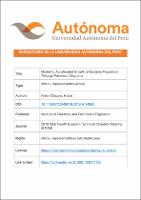Modeling Accelerated Growth of Bacteria Population Through Feynman Diagrams
Publisher
Institute of Electrical and Electronics Engineers
Journal
2019 IEEE Fourth Ecuador Technical Chapters Meeting (ETCM)
Additional Links
https://www.scopus.com/inward/record.uri?eid=2-s2.0-85082011715&doi=10.1109%2fETCM48019.2019.9014865&partnerID=40&Abstract
In Quantum Physics normally the well-known Feynman Diagrams are used to calculate transition probabilities by which we can estimate predictions as to the expected measurement of a certain physical variables. In this paper we use this technique to estimate quantitative measurements of the rapid growth of a bacteria population dictated by binary fission as well as to make predictions to anticipate and tackle down their possible scenarios of aggregation. We have used the theory of the Feynman diagrams in conjunction to the propagator. The resulting probabilities are interpreted as the ones that allows us to measure the growth of the population under certain physical conditions. Once the formalism is defined, we pass to calculate amplitudes of probability in taking the example 2→2 processes. With the types: termophile and mesophile, we provide various master equations in order to compute the net number of bacteria for a time of up to 20 hours. The final error of the model has been of order of 7.5%. Mainly of the uncertainty comes from the lack of interpretation of the parameters brought from the physics model.
Type
info:eu-repo/semantics/article
Rights
info:eu-repo/semantics/restrictedAccess
Language
eng
Collections
- Ingeniería de Sistemas [332]


